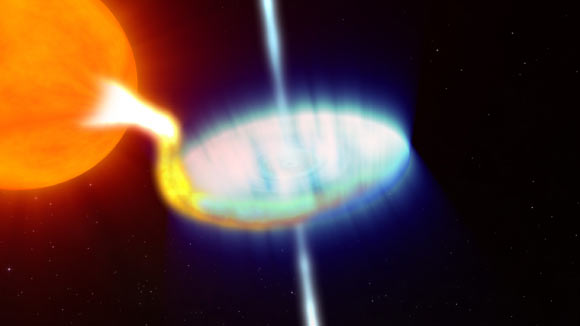A sudden flare from a low-mass black hole in the binary system V404 Cygni has offered astrophysicists a unique opportunity to make precise measurements of the black hole’s magnetic field, finding it weaker than expected. The results appear in the journal Science.

In V404 Cygni, a star slightly smaller than the Sun orbits a black hole 10 times its mass in only 6.5 days. The close orbit and strong gravity of the black hole produce tidal forces that pull a stream of gas from its partner. The gas travels to a storage disk around the black hole and heats up to millions of degrees, producing a steady stream of X-rays as it falls inward. Image credit: NASA / Goddard Space Flight Center / Conceptual Image Lab.
Observations of black holes consuming material ripped from a nearby star reveal that these binary systems amass material into an accretion disk. Above this disk lies an accretion disk coronae, the behavior of which is governed by its magnetic field.
Understanding the magnetic field within the accretion disk coronae is important because it affects the flow of gas around a black hole, yet there have been very few measurements of such fields to date.
On June 15, 2015, astronomers detected a sudden flare from the V404 Cygni binary system, which lies 8,000 light-years from Earth and contains a 40-mile (64 km) wide black hole.
“Smaller jet-producing black holes, like the one observed for the study, are the rock stars of galaxies. Their outbursts occur suddenly and are short-lived,” said University of Florida doctoral students in Yigit Dalilar and Alan Garner.
The 2015 outbursts of V404 Cygni lasted only a couple of weeks; the previous time the same black hole had a similar episode was in 1989.
“To observe it was something that happens once or twice in one’s career. This discovery puts us one step closer to understanding how the Universe works,” Dalilar said.
Yigit, Garner and their colleagues examined moments when there was a sudden drop in the V404 Cygni system’s electromagnetic radiation as the accretion disk coronae cooled.
They found the magnetic energy around the black hole is about 400 times lower than previous crude estimates.
The measurements bring scientists closer to understanding how black holes’ magnetism works, deepening our knowledge of how matter behaves under the most extreme conditions — knowledge that could broaden the limits of nuclear fusion power and GPS systems.
“The measurements also will help scientists solve the half-century-old mystery of how jets of particles traveling at nearly the speed of light shoot out of black holes’ magnetic fields, while everything else is sucked into their abysses,” said co-author Professor Stephen Eikenberry, also from the University of Florida.
“Our surprisingly low measurements will force new constraints on theoretical models that previously focused on strong magnetic fields accelerating and directing the jet flows. We weren’t expecting this, so it changes much of what we thought we knew.”
_____
Yigit Dallilar et al. 2017. A precise measurement of the magnetic field in the corona of the black hole binary V404 Cygni. Science 358 (6368): 1299-1302; doi: 10.1126/science.aan0249







